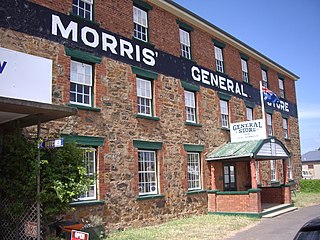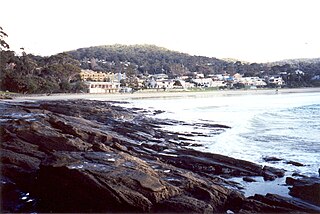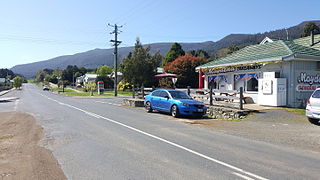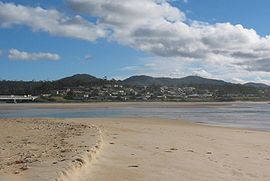
Launceston is a city in the north of Tasmania, Australia, at the confluence of the North Esk and South Esk rivers where they become the Tamar River (kanamaluka). Launceston has a population of 87,645 (2021). Launceston is the second most populous city in Tasmania after the state capital, Hobart, As of 2020, Launceston is the 18th largest city in Australia. Launceston is fourth-largest inland city and the ninth-largest non-capital city in Australia. Launceston is the most liveable regional city, and was one of the most popular regional cities to move to in Australia from 2020 to 2021. Launceston won the Australian town of the year in 2022.

Swansea is a town in the heart of Tasmania's east coast, on the north-west shore of Great Oyster Bay and overlooking Freycinet National Park. It was the first municipality in Australia to be established after Hobart and Sydney. At the 2021 census, Swansea had a population of 997.

Strahan, is a small town and former port on the west coast of Tasmania. It is now a significant locality for tourism in the region.

New Norfolk is a town on the River Derwent, in the south-east of Tasmania, Australia. At the 2011 census, New Norfolk had a population of 5,543.

St Helens is the largest town on the north-east coast of Tasmania, Australia, on Georges Bay. It is known as the game fishing capital of Tasmania and is also renowned for its oysters. It is located on the Tasman Highway, about 160 km east of Tasmania's second largest city, Launceston. In the early 2000s, the town was one of the fastest growing areas of Tasmania, and reached a population of 2049 at the 2006 census. By the time of the 2021 census, it had a population of 2,206.
Smithton is a town on the far north-west coast of Tasmania, Australia. It lies on the Bass Highway, 85 km north-west of Burnie. At the 2016 census, Smithton had a population of 3,881. Smithton is the administrative centre of the Circular Head Council.

Ulverstone is a town on the northern coast of Tasmania, Australia on the mouth of the River Leven, on Bass Strait. It is on the Bass Highway, 21 kilometres (13 mi) west of Devonport and 12 kilometres (7 mi) east of Penguin.

Wynyard (/ˈwɪnjɚd/) wi-nyuhd) is a rural town located on the North West coast of Tasmania, Australia. Wynyard is situated 17 kilometres (11 mi) west of Burnie. As of the 2016 census, Wynyard has an estimated urban population of 5,168 and a total greater area population of 6,001. The town is a regional hub servicing the surrounding rural areas, the adjacent Burnie Wynyard Airport provides commercial flights to Melbourne and other districts. The main council offices for the Waratah-Wynyard local government area are located in Wynyard.

Lorne is a seaside town on Louttit Bay in Victoria, Australia. It is situated about the Erskine River and is a popular destination on the Great Ocean Road tourist route. Lorne is in the Surf Coast Shire and at the 2016 census had a population of 1,114 but this figure grows during the holiday season.
Strathgordon is a rural locality in the local government area (LGA) of Derwent Valley in the South-east LGA region of Tasmania. The locality is about 121 kilometres (75 mi) west of the town of New Norfolk. The 2016 census recorded a population of 15 for the state suburb of Southwest, which includes Strathgordon. It is on the road to the Gordon River dam the most south westerly road in the south west of Tasmania. It is a tourist destination for visitors wishing to visit the Southwest National Park and World Heritage listed wilderness.

Orford is a village on the east coast of Tasmania, Australia 73 kilometres north-east of Hobart. It is the home of the joint champions of T20 Cricket in Tasmania. The village is centred on the mouth of the Prosser River, on the southern margin of a substantial coastal inlet called Prosser Bay. Beyond this bay are the waters of the Mercury Passage. At the 2006 census, Orford had a population of 553.

South West Rocks is a town located on the Mid North Coast of New South Wales, Australia, near the mouth of the Macleay River. It is approximately 40 km (25 mi) from Kempsey. Jerseyville is located nearby.

Fitzroy Crossing is a small town in the Kimberley region of Western Australia, 400 kilometres (250 mi) east of Broome and 300 kilometres (190 mi) west of Halls Creek. It is approximately 2,524 kilometres (1,568 mi) from the state capital of Perth. It is 114 metres (374 ft) above sea level and is situated on a low rise surrounded by the vast floodplains of the Fitzroy River and its tributary Margaret River.

Maydena is a locality in Tasmania, Australia, alongside the River Tyenna.

Forster is a coastal town in the Mid North Coast region of New South Wales, Australia, in the Mid-Coast Council LGA, about 308 km north-north-east of Sydney. It is immediately adjacent to its twin, Tuncurry, which is the smaller of the two towns. Forster is known for its stunning waters and Manning Valley beauty.
Ouse is a locality and small town in the Central Highlands Council local government area in Tasmania, Australia on the Lyell Highway. At the 2016 census, Ouse had a population of 303.

Geeveston is a small town in the south of Tasmania in Australia on the Huon River, 62 km (39 mi) south west of Hobart, making it Australia's most southerly administrative centre. The town takes its name from William Geeves, an English settler who was given a land grant by Lady Jane Franklin in the area then known as Lightwood Bottom. The settlement Geeves set up was renamed Geeves Town in 1861, and the name eventually became Geeveston. Geeveston is for local government purposes included in the area of the Huon Valley Council and is part of the division of Franklin for both Australian House of Representatives and Tasmanian House of Assembly electoral purposes.

Dorrigo, a small town on the Waterfall Way, is located on the Northern Tablelands, in northern New South Wales, Australia. The town is part of Bellingen local government area.
Beechford is a rural locality in the local government area (LGA) of George Town in the Launceston LGA region of Tasmania. The locality is about 22 kilometres (14 mi) north-east of the town of George Town. The 2016 census has a population of 90 for the state suburb of Beechford. It is a small beach side village on the northern coast of Tasmania, 48.0 kilometres (29.8 mi) north of Launceston. Beechford is also the place where the Curries River joins up with the Tasman Sea in Bass Strait. The village is surrounded by farmland, and land administered by Crown Lands, the Department of Defence, and Parks and Wildlife, creating a natural corridor of unbroken sea views. This beautiful part of Tasmania, with its warm, relatively dry micro-climate and stunning beach and conservation areas, is still "undiscovered" by tourism, leaving visitors to enjoy the area relatively undisturbed.

Liawenee is a small town in Tasmania, Australia built near Great Lake and the River Ouse, and was established on 11 June 1920. The town is an ex-Hydro village and now a residence for Inland Fisheries Services (IFS) and a Tasmania Police station. It is known for its exceptional fishing at nearby Great Lake and hosts several trout fishing events.

















